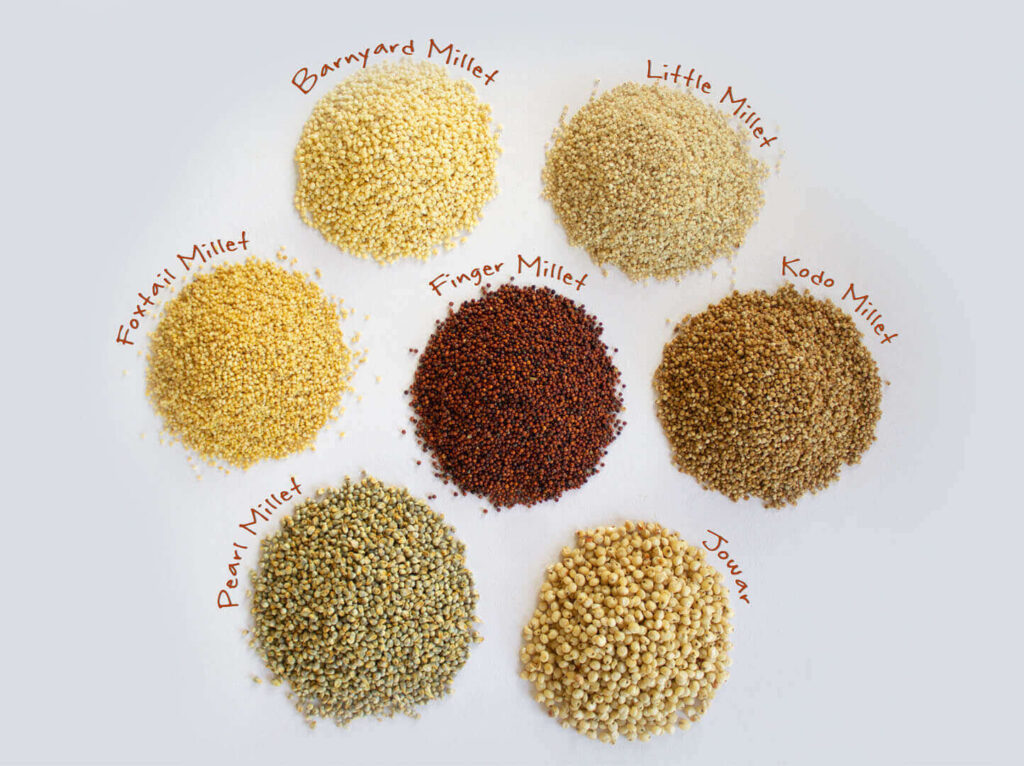About Millets
Millets are small-grained, annual, warm-weather cereals belonging to grass family. These are highly nutritious, gluten-free, boast high protein, fiber and antioxidant content as well as non-acid forming foods. Millets are the ancient crops of the mankind and are important for rainfed agriculture. These are widely consumed in developing countries throughout Africa and Asia. These are low maintenance and drought resistant grain. These provide various health benefits such as protecting heart health, and helping to maintain a healthy weight.

Types of Millets
There are more than 20 different types of millets. Some of the common and popular varieties include:
- Barnyard Millet is a high source of iron and fiber. It is known as Kuthiravali in Tamil, Oodhalu in Kannada, Oodalu in Telugu, Kavadapullu in Malayalam and Sanwa in Hindi.
- Finger Millet is a staple that is a very good substitute for oats and cereals. It is known as Ragi in Kannada, Ragulu in Telugu, Kelvaragu in Tamil, Panji Pullu in Malayalam and Mundua in Hindi.
- Foxtail Millet is rich in minerals and vitamins. It is known as Thinai in Tamil, Korra in Telugu, Thinna in Malayalam, Navane in Kannada and Kangni in Hindi.
- Little Millet is also loaded with iron and fibre. The regional names are Chama in Malayalam, Saame in Kannada, Saamai in Tamil, Sama in Telugu and Kutki in Hindi.
- Kodo Millet is known as Koden in Hindi, Varagu in Tamil, Koovaragu in Malayalam, In Kannada it is called Araka and Arikelu in Telugu
- Pearl Millet is a high source of proteins, it is known as Bajra in Hindi, Sajje in Kannada, Sajjalu in Telugu, Kambu in Tamil and Kambam in Malayalam
- Sorghum Millet is a super energizing food that has anti-inflammatory, anti-cancer and weight loss effects. It is known as Jowar in Hindi, Cholam in Tamil and Malayalam, Jonnalu in Telugu, Jola in Kannada.

Health Benefits
Millets are rich in nutrients. Consuming these in moderation is always beneficial for humans. Therefore, they offer multiple health benefits as below:
- Rich in anti-oxidants
- Help in control blood sugar levels
- Help lower cholestrol
- Fits a gluten-free diet
- Helps in managing weight
Potential Downsides
Despite millets’ multiple health benefits, they also contain antinutrients – compounds that block or reduce your body’s absorption of other nutrients and may lead to deficiencies.
One of these compounds called Phytic Acid that interferes with potassium, calcium, iron, zinc, and magnesium uptake. However, a person with a balanced diet isn’t likely to experience adverse effects.
Other antinutrients called Goitrogenic Polyphenols may impair thyroid function. However this effect is associated only with excess polyphenol taking.
Furthermore, you can lower millet’s antinutrient content significantly by soaking it overnight at room temperature, then draining and rinsing it before cooking. Plus, sprouting reduces antinutrient content.
How to prepare and eat millets
Millets are now-a-days available in many grocery and health food stores, and people can also purchase it online. People can buy millets as whole grains, flakes, rava and flour form.
Though millets contain phytic acid which is nutrient inhibitor, so longer soaking is needed to release the phytic acid content which will help in better nutrient absorption. So it is advisable to soak whole millet for about 6-8 hours or overnight before cooking. However, duration of soaking differs from millet to millet. Also soaking helps to cook the grains faster.
However, if using millets in rava or flakes form, we may slightly roast it before cooking. and if using in flour form, we may use it directly without any pre-preparation.
Summary
Millet is an ancient grain that people have enjoyed for thousands of years. Millet is also food for livestock and birds. It is becoming increasingly popular as it is fast-growing, drought-resistant, and requires low input.
Millet is a good source of protein, fiber, key vitamins, and minerals. The potential health benefits of millet include protecting cardiovascular health, preventing the onset of diabetes, helping people achieve and maintain a healthy weight, and managing inflammation in the gut.
Millet is an adaptable grain. There are many simple ways to prepare it, making it easy for people with celiac disease to include this gluten-free grain in their diets.
Disclaimer: This is only intended for an informational purpose. Readers are subjected to use this information on their own risk. This website doesn’t take any responsibility for any harm, side-effects, illness or any health or skin care problems caused due to the use of our content or anything related to this.. The content is offered on an informational basis only, and is not intended to be a substitute for professional medical advice, diagnosis, or treatment. Always seek the guidance of a qualified health provider before making any adjustment to a medication or treatment you are currently using, and/or starting any new medication or treatment. All recommendations are “generally informational” and not specifically applicable to any individual’s medical problems, concerns and/or needs.